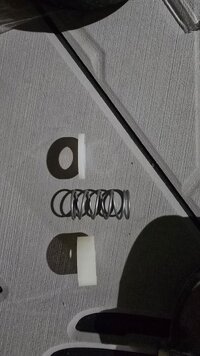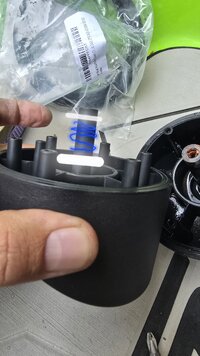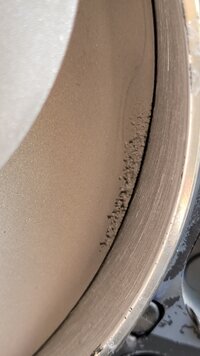Some how I ignored this thread. So I have had cavitation since new. At 45hr I had sings of cavitation erosion on the impellers. I have done most of the other fixes to the pumps /impellers and pump Housing transom alignment. And it did mostly fix it. . I have always had the issue when coming off throttle water would push up past the manholes. But always had water sitting on top even after driving again. So water pushed past but not sucking water out when accelerating. So not sucking in air either? We'll this season I have noticed 1 not holding water. And started the rebuild. Both units had 2 or 3 broken plastic posts that the screws into.
During this rebuild I noticed that the seals didn't push down very well (poor design). So I added a spring and 2 nylon washers. This will apply more downward force.
I do plan to tryout the O-ring also.
Also a picture of the cavitation erosion.
Did you replace the existing spring, or did you not even have a spring in your cleanout plug? There's one in there, but in thinking about it, I've never considered it as a potential issue.
It seemed like it was in there to allow some friction for the "SET" tab. I can honestly say I didn't think it had anything to do with the rubber skirt and the seal.
Looking forward to hearing your results on your ideas
*edit* the rubber skirts will not drain back out once water is in there for my boat - unsure of your setup. Water WILL drain when the boat rests overnight, but only down to the waterline, which is about an inch above the plugs for me.
While underway, no suction occurs, since the water is being forced past the seals. This is why the O-rings have been a success, as no water enters in the first place.
For me, at least on my starboard side, it's a godsend. Port side, I'm still dealing with intrusion, but I will be trying a 3D printed ring vs an o-ring, which will allow different heights.
If that works, I'll explain my theory at that point, and provide the STL files and possibly print some for others to test. It's a dead simple print, get the correct dimensions for the inside and outside diameters, and dial in the correct height, and/or spit out multiple heights.
The O-rings are a perfect solution for many, and a perfect starting point for those like myself, where it's just a frog's hair too much (or not enough), to solve one of the final puzzle pieces to get a dry bilge





